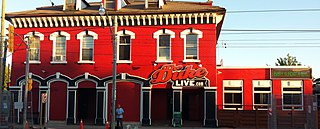
Queen Street is a major east–west thoroughfare in Toronto, Ontario, Canada. It extends from Roncesvalles Avenue and King Street in the west to Victoria Park Avenue in the east. Queen Street was the cartographic baseline for the original east–west avenues of Toronto's and York County's grid pattern of major roads. The western section of Queen is a centre for Canadian broadcasting, music, fashion, performance, and the visual arts. Over the past twenty-five years, Queen West has become an international arts centre and a tourist attraction in Toronto.

Spadina Avenue is one of the most prominent streets in Toronto, Ontario, Canada. Running through the western section of downtown, the road has a very different character in different neighbourhoods.

The Fairmont Royal York, formerly and still commonly known as the Royal York, is a large historic luxury hotel in Toronto, Ontario, Canada. Located along Front Street West, the hotel is situated at the southern end of the Financial District, in Downtown Toronto. The Royal York was designed by Ross and Macdonald, in association with Sproatt and Rolph, and built by the Canadian Pacific Railway company. The hotel is currently managed by Fairmont Hotels and Resorts.

Spadina is a subway station on Line 1 Yonge–University and Line 2 Bloor–Danforth in Toronto, Ontario, Canada. It is located on Spadina Road, north of Bloor Street West. It is one of only two stations open overnight, along with Union station. Wi-Fi service is available at this station.

Front Street is an east–west road in downtown Toronto, Ontario, Canada. First laid out in 1796, the street is one of the original streets of the Town of York. The street was laid out along the shoreline of Lake Ontario as it existed during that time. It remains an important street, with many important uses located along it, including the St. Lawrence Market, Meridian Hall, Union Station and the Metro Toronto Convention Centre. The eastern section of Front Street, in the West Don Lands, east of Cherry Street, is being rebuilt as a broad tree-lined boulevard, intended to be the pedestrian-friendly commercial spine of the new neighbourhood.

510 Spadina is a Toronto streetcar route in Ontario, Canada, operated by the Toronto Transit Commission.

Wilson Yard is the largest of the Toronto Transit Commission's subway yards and bus garages. The subway yard services subway trains on Line 1 Yonge–University. The facility is located on Transit Road north of Wilson Avenue, in the former city of North York, between Wilson and Sheppard West stations.

Queens Quay is a prominent street in the Harbourfront neighbourhood of Toronto, Ontario, Canada. The street was originally commercial in nature due to the many working piers along the waterfront; parts of it have been extensively rebuilt in since the 1970s with parks, condominiums, retail, as well as institutional and cultural development.
The Sapphire Tower was a proposed luxury hotel and condominium skyscraper in Toronto, Ontario, Canada, to be built by developer Harry Stinson. It was so named because all plans for it had deep blue glass curtain walls. This site had been involved in numerous other proposals, including Stinson's own Downtown Plaza concept, and an earlier proposal that would have incorporated the neighbouring Graphic Arts Building.

The Duke of York, known as the Duke of York Hotel for many years and now as Duke Live, is a historic structure in Leslieville, Toronto, Ontario. It is located at 1225 Queen Street East, at the corner of Queen Street and Leslie Avenue.

Ocean Island Inn is a historic building in Victoria, British Columbia, Canada; it is Vancouver Island's largest backpackers' inn.

The People's Palace is a heritage-listed building and a former temperance hotel in the Brisbane CBD, City of Brisbane, Queensland, Australia. It is located at 308 Edward Street on the southern corner with Ann Street, diagonally opposite to Brisbane's Central Railway Station. It was designed by Colonel Saunders and built from 1910 to 1911. It was added to the Queensland Heritage Register on 21 October 1992.

The former Imperial Hotel is located at the corner of Fort and Queen Street in Auckland, New Zealand. It was built in 1883 and is now a notable example of Victorian architecture. The building was registered as a category II heritage structure by the New Zealand Historic Places Trust in 1987. The building's current use is as a backpackers hostel, pub, and communal lounge.

The Dineen Building is a registered heritage property on Yonge Street, at the corner of Temperance Street, in downtown Toronto, Ontario, Canada. The building was built in 1897, and was extensively renovated in 2012.
Frederick Henry Herbert (1865–1914) was an architect practicing in Toronto, Ontario, during the late 19th century and early 20th century. Several buildings that he designed have survived into the 21st century and have been registered as significant heritage properties. He was one of the city's best-known practitioners specializing in residential architecture at the close of the 19th century.

The National Hotel was a hotel built on the southeast corner of King and Sherbourne streets, in Toronto, Ontario, Canada. Under pressure for condominium apartment redevelopment, the City of Toronto attempted to preserve the building, designating it a heritage site in 2009, but the building was eventually torn down in 2013. The hotel's north and west facades were preserved as part of the new condominium development, examples of "facadism" in Toronto.

The Toronto Transit Commission operated a separate Spadina streetcar line on Spadina Avenue, from 1923 to 1948. Spadina Avenue is a major north–south road in downtown Toronto.

Mike Filey was a Canadian historian, radio host, journalist and author. He was awarded the Jean Hibbert Memorial Award in 2009 for promoting the city of Toronto and its history.



















